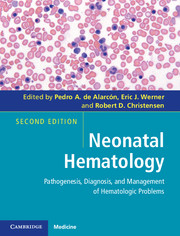Book contents
- Frontmatter
- Contents
- Contributors
- Foreword
- Preface
- 1 A historical review
- Section I Developmental hematology
- Section II Erythrocyte disorders
- Section III Platelet disorders
- Section IV Leukocyte disorders
- Section V Immunologic disorders
- Section VI Hemostatic disorders
- Section VII Transfusional medicine
- Section VIII Miscellaneous
- 20 Disorders of the feto-maternal unit
- 21 Neonatal oncology
- 22 Reference ranges in neonatal hematology
- Index
- Plate section
- References
20 - Disorders of the feto-maternal unit
from Section VIII - Miscellaneous
Published online by Cambridge University Press: 05 February 2013
- Frontmatter
- Contents
- Contributors
- Foreword
- Preface
- 1 A historical review
- Section I Developmental hematology
- Section II Erythrocyte disorders
- Section III Platelet disorders
- Section IV Leukocyte disorders
- Section V Immunologic disorders
- Section VI Hemostatic disorders
- Section VII Transfusional medicine
- Section VIII Miscellaneous
- 20 Disorders of the feto-maternal unit
- 21 Neonatal oncology
- 22 Reference ranges in neonatal hematology
- Index
- Plate section
- References
Summary
Introduction
The fetal–placental–maternal unit can produce significant abnormalities in the neonate’s hematologic health at birth. A newborn can have disorders in white blood cells, red blood cells, or platelets, or any combination thereof. Neonatal cytopenias can result from dilution, peripheral destruction, or a defect in cellular production (1). Maternal illness can be the cause of such abnormalities (Table 20.1). Close communication between the obstetrical provider and the pediatrician is important. This can allow for anticipation of a problem in order to mitigate the consequences, or to discover the cause if an unexpected cytopenia is detected.
Thrombocytopenia
While only 1%–5% of all neonates will have a platelet count below 150 000/µL, as many as 35% of infants admitted to the neonatal intensive care unit will have this finding (2). The most common cause of early onset thrombocytopenia is chronic fetal hypoxemia such as with intrauterine pre-eclampsia and its variants, and uncontrolled diabetes. This type of thrombocytopenia is usually self-limited and mild and results from a bone marrow effect with a resulting decrease in megakaryocytes.
Additional causes related to the maternal fetal unit include immune-mediated disorders such as neonatal alloimmune thrombocytopenia caused by isoimmunization of the mother against specific platelet antigens. Mothers with autoantibodies against platelet antigens can pass those antibodies transplacentally to the infant, resulting in neonatal thrombocytopenia. Other causes include intrauterine infections and neonatal sepsis.
- Type
- Chapter
- Information
- Neonatal HematologyPathogenesis, Diagnosis, and Management of Hematologic Problems, pp. 337 - 368Publisher: Cambridge University PressPrint publication year: 2013



